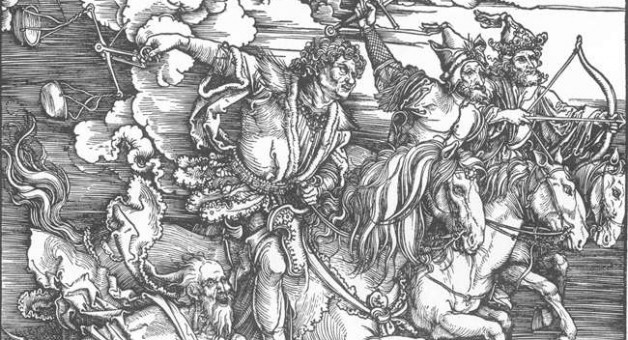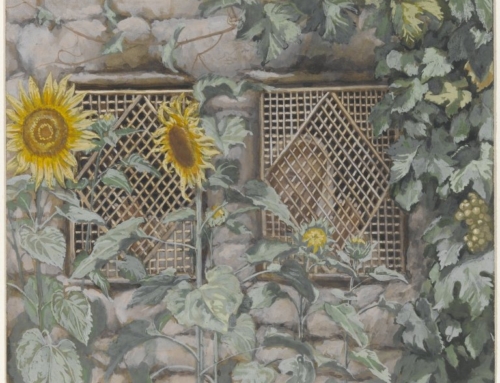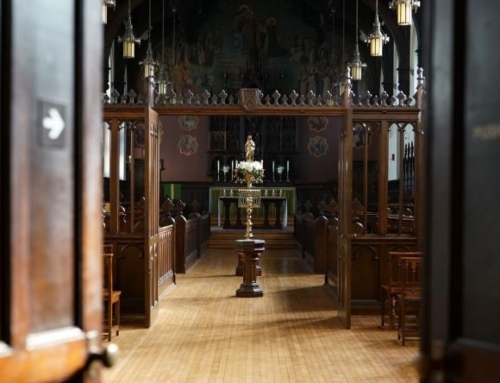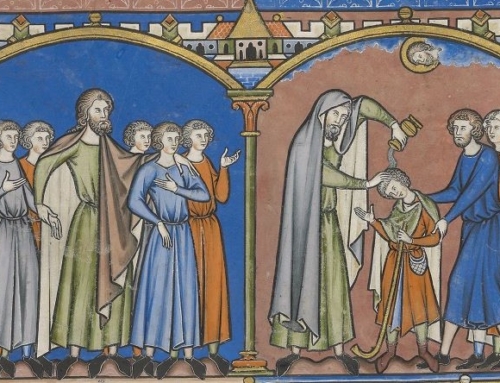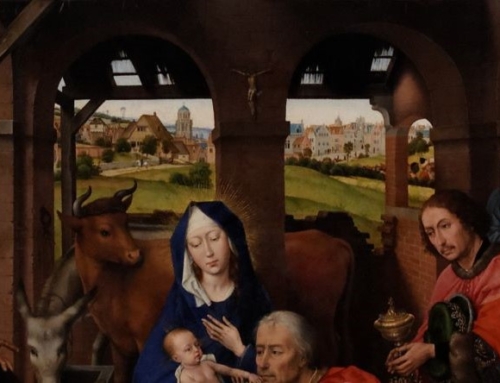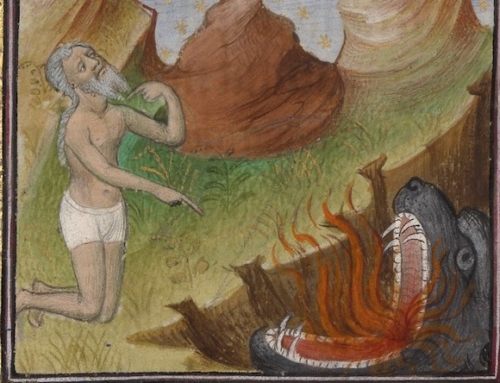In this post, we will cover some of the more famous images in the first half of the Book of Revelation.
Chapter 5—The Lamb and the Living Creatures
The Lamb that is the focal point of this chapter has seven horns and seven eyes. These are symbolic numbers, of course. Seven means fullness, perfection. The horn in the Old Testament is a standard symbol of power. “Lamb” is a typically Johannine name for Jesus. The “living creatures” around the Lamb should remind us of the Books of Ezekiel and Isaiah. Revelation doesn’t say the creatures are angels, but their descriptions have some of the same elements as the previous prophets’ angels: six wings, crying “Holy Holy Holy” (Isaiah), and the four lion, ox, man, and eagle creatures (Ezekiel).
The context for the vision of the sealed scroll that cannot be read in Revelation 5:1-10 is Isaiah 29:11-14. Isaiah says that the vision he reports is like a sealed scroll that cannot be read, both because it is sealed and because the knowledge to read it is lacking. In Revelation, Jesus the Lamb is the one who can break open the seal and read the scroll. St. Bede here recalls the words of Matthew 13:17, where Jesus says that many prophets and righteous men longed to see what the Apostles see. St. John’s vision symbolically says that Jesus is the fulfillment of the mysteries of Isaiah and all the prophets.
Chapter 6—The Four Horsemen of the Apocalypse.
As the first four seals of the scroll are opened, four horsemen appear riding horses of different colors. This evokes the apocalyptic prophecies of Zechariah 1, where the riders “are they whom the Lord has sent to patrol the earth.” They represent the might of God, which reaches over the whole earth. In the Bible horses are always associated with war; divine judgment is at hand. St. Bede sees the seven seals (of which the horsemen correspond to four) as a sort of condensed symbol of salvation history in the era of the Church. The white horse is the Church, the next three the powers God allows to afflict the Church, the fifth the glory of the triumphant, the sixth the time of the Antichrist, and the seventh the beginning of eternal peace.
As the further seals are opened, there is an earthquake, darkening of the sun, reddening of the moon, falling of the stars, and other calamities. It is certainly fitting that the Day of the Lord be attended by cosmic upheavals. But in the Book of Revelation the Lord is not primarily trying to warn us about the danger of dying in an earthquake; we have seen that Jesus says not to fear that which can kill the body, and we have seen that the images in the visions of the Old Testament prophets were generally about spiritual realities. Therefore we are on good ground if we interpret these worldly calamities in John’s prophetic vision as signs of spiritual calamities, such as persecutions and an increase in evildoing. This is how St. Bede sees it. In Jesus’ apocalyptic discourse of Matthew 24, he promises both earthquakes and a multiplication of wickedness as signs of “the close of the age.” We have already seen how this saying of Jesus’ can be read with reference to the destruction of the Temple in 70 AD, the persecutions of the Church in John’s time, and many other events through history. We should also remember that it has been the “end times” ever since the Ascension of Christ (see CCC 673).
Chapter 7—The One Hundred Forty-Four Thousand
The servants of God are sealed on their foreheads with the seal of God, recalling the vision from Ezekiel 8-9. Remember that the forehead mark in Ezekiel’s vision was a symbol for the spiritual state of the people, indicating whether they were faithful to God or whether they were guilty of wickedness and idolatry. Therefore we should expect that St. John’s equivalent is symbolic in the same way. In St. John’s vision the number of those sealed is “144,000.” Writing it with digits is a bit deceptive, because it is not the mathematical, quantitative value that is important, but the symbolic value of the number. Everything else in this vision is a symbol, so we should not be deceived into thinking that fewer than 144,001 people will be saved. Symbolic numbers are often composed by multiplication, as when Jesus says that forgiveness should be “seventy times seven” (imagine the absurdity of saying, “Sorry, bro—that’s 491. You used ’em all up.”). The number 144,000 is 12 x 12 x 1,000. In the language of Biblical symbolism, this means “Israel, Israel, very very large.” The following vision, Rev 7:9-17, is a re-presentation of the same thing in different terms, as often happens in prophetic visions. There the elect are “a great multitude which no one could count” (Rev 7:9). The elect are the Church, Israel of the New Covenant.
Chapters 8 & 9—More Calamities
As we have seen with reference to Old Testament prophecies, it is best to interpret these calamities as symbols of spiritual realities, of spiritual crises. This is how St. Bede interprets all these things. The Church seems to agree that this is the main focus of the text, for the Catechism does not warn that we should beware of earthquakes in the end times, but it testifies that the Church expects a “final trial” (CCC 675), the Antichrist (with a capital A, CCC 676), and a “final unleashing of evil” (CCC 677). The idea of spiritual struggle also helps us interpret images like “hail and fire mixed with blood,” “the star called wormwood,” and so forth.
Chapter 9—The Scorpion-Locusts
St. Bede interprets the scorpion-locust creatures that afflict people in chapter 9 as heretics who afflict people spiritually by teaching them false doctrine. The first time I read this I thought, “St. Bede, with you everything’s heretics!” Indeed, he does interpret many of the calamities in St. John’s vision as spiritual calamities caused by those who spread false doctrine. But given what we have learned about prophetic interpretation, this is not as unreasonable as it might seem at first glance. He makes a particularly good case for it in this passage.
He notices that the locusts in the vision don’t attack plants as real locusts are wont to do, but men. This is a tip-off that the locusts stand for a kind of men. Remember also that we have learned from Daniel to expect the monsters in prophetic visions to represent spiritual villains. In Daniel all the spiritual monsters were wicked men, though we will see that in Revelation the devil is also represented as a monster, a dragon. Another clue is that the locusts don’t hurt everyone, but only those who don’t have the seal of God on their foreheads. This tells us that their attack must symbolize some kind of sin contrary to God, because it does not happen to those who belong to God.
Image: Albrecht Durer, The Revelation of St John 4: The Four Riders of the Apocalypse

